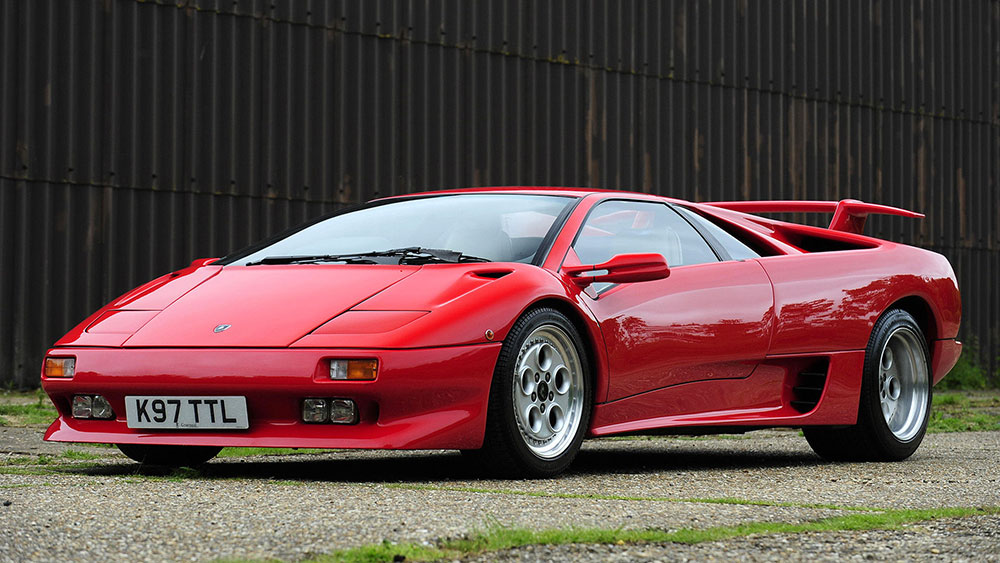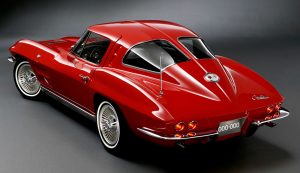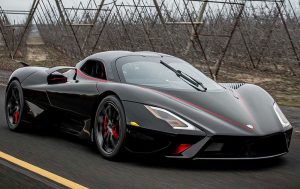Project 132 was the name given to the concept that Lamborghini took on to replace the Countach, as early as 1985.
Starting from scratch, designer Marcello Gandini (which was also responsible for drawing Miura and Countach) sketched a very aggressive, sharp body for what was to become the Diablo. Sketch was revised by Chrysler’s design center, which had become the majority shareholder of Automobili Lamborghini.
Since Lamborghini had a tradition of naming its cars after famous breeds of fighting bulls, Diablo was named after the bull that was raised by the Duke of Veragua and battled “el Chicorro” in 1869.
The Diablo was presented to the public for sale on 21 January 1990. Its power came from a 5.7 L (348 cu in) dual overhead cam, 4 valves per cylinder version of the existing V12 engine and computer-controlled multi-point fuel injection, producing a maximum output of 492 PS (362 kW; 485 hp) and 580 N⋅m (428 lbf⋅ft) of torque. The vehicle could reach 0-100 km/h (62 mph) in about 4.5 seconds, with a top speed of 325 km/h (202 mph). The Diablo was rear-wheel drive and the engine was mid-mounted to aid its weight balance.
Seats were now fully adjustable, as was the steering wheel and windows were actioned electrically. Hand-sewn fine Italian leather covered the insides of the car, top to bottom.
Various luxury perks were available with supercars; Lamborghini offered the possibility to buy a custom-moulded seat for the driver, rear spoiler, a factory luggage set and even a limited edition Breguet clock for your car’s dashboard.
The Lamborghini Diablo Roadster Concept
Introduced during the 1992 Geneva Auto Show, the Diablo Roadster allowed Lamborghini to showcase how the new supercar would look like with an open top. The Roadster not only had the roof removed, but the windshield was replaced by a lower visor. To compensate for the lack of roof, the chassis needed to be reinforced.

On the inside, the dashboard suffered a major redesign, becoming smaller in size but retaining all the required elements. Bigger clearance was created between the seats, allowing the windscreen mounted rearview mirror to reflect the world behind the car.
Lamborghini boosted the size of the air intakes on the rear wings and increased the cross section of air ducts running the sides of the concept.

While there were talks to make the concept into a limited edition run, the project never reached production. The concept generated a positive response among the public and demand among customers for such a car. As the car was not intended for production, German tuner Koenig Competition upon Lamborghini’s permission converted customer cars into replicas of the concept.
The Diablo VT- All-Wheel Drive
Introduced 3 years after the debut of Diablo, the VT brought on several changes. The most notable difference compared to the original Diablo is the addition of all-wheel drive. To integrate it, Lamborghini borrowed and redesigned the viscous differential (hence VT – Viscous Traction) in the 4WD system found on its military-spec LM002 model. The new drivetrain allowed 40% of the power to the front wheels.


The all-wheel-drive system made it easier to control the 492hp output of the roaring V12. Some would even say that Lamborghini took out the challenge of driving a Diablo when they introduced the 4WD in the VT model.
The Diablo SE30 and SE30 Jota
To celebrate 30 years of existence, Lamborghini released the limited-edition Diablo SE30 in 1993. The idea was rather simple: SE30 was a racecar somehow legal to drive on the streets.
The engine was tuned upwards to 523hp thanks to a new fuel system, magnesium intake manifolds and a free-flowing exhaust system.

Furthermore, the Lamborghini Diablo SE30 ditched the 4-wheel drive and resumed to powering just the rear wheels to shave off weight. To compensate for the obvious oversteer, Lamborghini engineers fitted adjustable anti-roll bars that the driver could control directly from the cockpit.
Like most racecars of the time, more weight was shed by replacing glass windows with plexiglass. Air conditioning, power steering, music – all were taken out in the name of lower weight. Fine Italian leather seats were taken out and replaced by lightweight carbon fiber counterparts which were also made to fit 4-point harnesses.

Only 150 SE30 models were built, and of these, about 15 were converted to “Jota” specification (although 28 Jota kits were produced). The “Jota” was a factory modification kit designed to convert the race-oriented SE30 into an actual circuit racer, albeit at the cost of street-legal operation. A revised engine lid with two ducts protruding above the roofline forced air into the intake system; a similar lid design would later be used on the Diablo SV model. With even more tuning of the Diablo’s venerable V12 engine, it had a power output of nearly 603 PS (444 kW; 595 hp) and 639 N⋅m (471 lb⋅ft) of torque. The rear-view mirror from the interior was also removed because it was completely useless in conjunction with the revised engine lid, further adding to the race feeling of the car.
The Diablo SV
The Geneva Motor Show was the host for Lamborghini’s new Diablo iteration. Named Diablo SV, the model revived the Super Veloce nomination used last time on the Miura SV.
Diablo SV was based on the original Diablo model and thus lacks a viscous differential and 4-wheel drive. On the bright side, the engine was revised, allowing it to push 510hp to the wheels at an eye-pleasing, eargasmic 7,100 RPM.

To account for the power boost, extra brake cooling ducts were integrated along with bigger 340mm front brakes. Bigger, 18” wheels were fitted to accommodate the increased diameter brakes.
A rear spoiler came standard with the SV, and it could have been painted in accordance to the rest of the car or built out of carbon fiber. Even with the revised engine, Lamborghini set the SV below the price of the standard Diablo.
Twenty limited run “Monterey Edition” Diablo SVs were built for the United States, most of them built in vibrant colors, something that was highly unusual for the Italian brand at the time.
The Diablo GT
Based on SE30 and SE30 Jota, Lamborghini revealed the Diablo GT in 1998. Compared to its tamer relatives, Diablo GT was built more for the track rather than for the public roads. This was prevalent not only via the revised design but also through the plethora of components unique to the model.

On the outside, huge brake ducts were fitted alongside an air dam and central vent flowing to the oil cooler. There was no luggage compartment left as a large air extractor was installed in place. NACA ducts replaced the small fender vents, with the fender themselves being widened to match the upgrades.
On the outside, huge brake ducts were fitted alongside an air dam and central vent flowing to the oil cooler. There was no luggage compartment left as a large air extractor was installed in place. NACA ducts replaced the small fender vents, with the fender themselves being widened to match the upgrades.
Aiding aerodynamics, bumpers were stripped and replaced by carbon fiber diffusers with integrated lamps. The engine sucked air through a central air duct that opened on the roof.

To get the car as light as possible, most of the bodywork was laminated in carbon fiber. It all summed up to a 300lbs weight reduction over the standard Diablo, translating to a 12 second quarter mile and a top speed of 210mph!
For the first time on the model, the V12 engine displacement was altered. Stroke was lengthened by 0.2 inches and made for a 6-liter total displacement. Power output was rated at 575hp and 465 lb-ft of torque.
The production was limited to only 83 units sold, each for an eye-watering $258,000 US dollars.
Diablo VT Roadster
The Diablo VT Roadster was introduced in December 1995 and featured an electronically operated carbon fibre targa top which was stored above the engine lid when not in use. Besides the roof, the roadster’s body was altered from the fixed-top VT model in a number of ways. The front bumper was revised, replacing the quad rectangular driving lamps with two rectangular and two round units. The brake cooling ducts were moved inboard of the driving lamps and changed to a straked design, while the rear ducts featured the vertical painted design seen on the SE30.

The engine lid was changed substantially in order to vent properly when the roof panel was covering it. The roadster also featured revised 17 inch wheels. The air intakes on top/sides were made larger than the Diablo coupé. In 1998, the wheels were updated to 18 inches, and the engine power raised to 530 hp (395 kW; 537 PS) by adding the variable valve timing system. Top speed was also raised to 335 km/h (208 mph).
To bring something to the prototype stage and trying to catch-up with Porsche, Lamborghini developed the GT1 Stradale with the help of French prototype builder Signes Advanced Technologies. As per GT1 class requirements, the GT1 Stradale featured a tubular steel chassis and carbon fiber bodywork. Powertrain was supplied by Lamborghini, a 6-liter V12 iteration that was capable of 655bhp at 7,550RPM, coupled to a 6-speed sequential gearbox.

In 1996, Diablo SV-R was shown to the public as a competition spec version of the existing SV. The SV-R was the first Lamborghini built specifically for racing, and the Italian automaker went as far as creating their own league called Lamborghini Supertrophy. Twenty-eight SV-Rs entered the event, built in just 4 months. Amazingly, all of them finished the race without major issues.
One of the rarest Lamborghini Diablo existing today, the GTR was launched after the immense success witnessed by the SV-R. Like a proper race-oriented car, the Lamborghini Diablo GTR was stripped down to the minimum required to save weight, 6-point belts were added as well as huge rear spoiler, integrated air jacks and 18-inch center-lock OZ wheels. The 60liter V12 engine would push 590hp and was bolted to the regular 5-speed manual transmission powering the rear wheels.
With various iteration and even a racing event dedicated to the model, Lamborghini managed to create a more-than-worthy successor of Countach. A true raging bull, which, regardless of its form, delivered raw power and made the driver earn each turn on the track.
Share this:
- Click to share on Facebook (Opens in new window)
- Click to share on Twitter (Opens in new window)
- Click to print (Opens in new window)
- Click to share on LinkedIn (Opens in new window)
- Click to share on Reddit (Opens in new window)
- Click to share on Tumblr (Opens in new window)
- Click to share on Pinterest (Opens in new window)
- Click to share on Pocket (Opens in new window)
- Click to share on Telegram (Opens in new window)
- Click to share on WhatsApp (Opens in new window)




